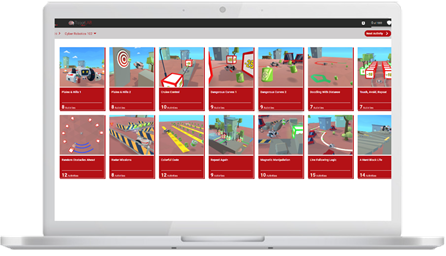High-quality and engaging online learning programs have a number of common characteristics.

Online learning’s reputation has taken a hit in recent years amid reports of poor academic performance and concerns over lax regulation. While there is certainly some cause for concern, many of the problems center on for-profit providers who manage full-time virtual schools. The truth is that not all online learning experiences are of suspect quality.
When done well, online learning can be highly successful—opening the door to numerous learning opportunities that students otherwise wouldn’t be exposed to, while providing very rich and rigorous instruction. In fact, students who take online Advanced Placement courses from VHS Learning consistently outperform national passing rate averages on AP exams.
What are the elements that lead to high-quality online learning? They’re the same components that define high-quality learning in general. Here are seven key characteristics to look for in an online program.
1. Qualified teachers
At the heart of any effective learning experience is the teacher and his or her relationship with students. This is true for both face-to-face and online instruction.
To ensure they are highly qualified, the teachers in an online program should be certified in their subject area. If they’re teaching an AP course, they should attend the College Board’s AP Summer Institute training. Teachers should be adept at inspiring wonder, giving effective feedback, and forging a strong connection with students.
For us, online learning isn’t really about the technology; the technology is merely the conduit for building relationships between teachers and students. Still, teaching in an online environment is different than teaching in a face-to-face classroom.
Online teachers should be highly skilled at teaching in a virtual environment, which is why all our teachers are required to successfully complete a graduate-level course in effective online teaching practices—where they learn how to facilitate online discussions and make sure students are fully supported throughout their experience.
2. Engaging curriculum
A high-quality online learning experience delivers highly engaging instruction in which students interact frequently with each other and with their teacher, not just with a piece of software.
As in a traditional classroom, students should be completing hands-on, authentic tasks and projects and engaging in rich discussions about the material with their peers. Every assignment should have a clearly articulated learning objective, along with rubrics for measuring success. Assessments should include projects, labs, and other performance tasks, not just multiple-choice exams. And students should have opportunities to reflect on and revise their work, not simply turn in an assignment and move on.
3. Sense of community
One of the challenges involved in taking classes online is the sense of isolation that students might feel when they’re not sitting in a traditional classroom surrounded by their peers. Effective online learning solves this problem by establishing a strong sense of community among students, so they feel connected with each other and their teacher.
This can be done by having students interact with one another frequently as part of their coursework. At the beginning of a course, teachers should assign “icebreaker” activities to help students get to know each other and feel comfortable interacting with their peers online. Clear ground rules should be established on how to interact and give peer feedback respectfully, so that everyone feels welcome within the online learning community. All students should have a voice and be active participants in their online classroom.
4. Adequate structure
An important benefit of learning online is the degree of flexibility and personalization it enables. Yet, students still need structure in place to help ensure they are able to finish their coursework successfully and on time. A fully self-paced course without established deadlines might work well for high achievers who are self-motivated, but many students will end up lost if they don’t have a clear structure to guide them.
A high-quality online learning experience strikes the right balance between flexibility and structure. For example, weekly due dates can help keep students moving forward. Within the established timeframes, students can be free to complete assignments when it’s convenient for them to do so.
5. Small class sizes
Many for-profit providers rely on technology to deliver much of their instruction, and the teacher’s role is minimal. This allows providers to keep their costs low in order to maximize profits through high student-to-teacher ratios, but students end up paying the price when they don’t have a lot of personal interaction with an instructor.
As they do in a traditional classroom, students who are taking courses online learn best with smaller class sizes, where the teacher can give each student support and personalized feedback about his or her work. Our online classes are typically capped at 25 students, with an average student-to-teacher ratio of 21 to 1.
6. Frequent feedback
Research from John Hattie and other academics confirms what educators already know to be true: The more feedback students receive about their work, the more effectively they learn.
As in a brick-and-mortar classroom, high-quality online instruction must include frequent opportunities for students to receive substantive feedback that guides their improvement.
7. High-touch support
Students need to be supported throughout their educational journey, and that’s especially true when they’re learning in an online environment.
An effective online learning experience should include some kind of orientation for students at the outset, so they know what it takes to succeed in the course (and how they can ask for help). Teachers should check in with each student on an individual basis several times per week, and typically more frequently, to make sure they don’t feel lost in the class. What’s more, there should be a qualified online program coordinator on site—a librarian, a teacher, or a paraprofessional—who can provide direct support to students and serve as a liaison between the student and online instructor as needed.
It’s not only the students who need support. For online learning to be effective, school leaders need support in implementing the program—and site coordinators need training in how to support students most effectively.
The keys to effective online learning aren’t a secret. They’re the same elements that lead to high-quality learning overall. We’ve integrated these elements into our online courses for more than two decades, with remarkable success. Our experience proves that when implemented well, online learning can indeed be very effective.

Keep learning during COVID-19 with RobotLAB and CoderZ!
CoderZ is an online educational environment that improves students 21st century skills, while they are having fun programming their own virtual cyber robot. CoderZ and RobotLAB has different lessons to do at home! Check them out Here
